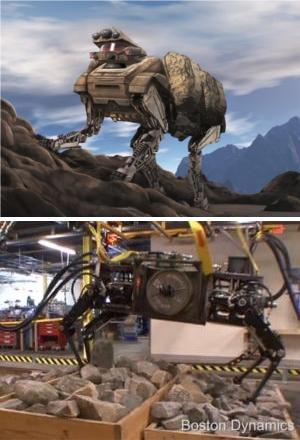
The Alpha Dog is like any large puppy – it doesn’t mind you shoving it around, but when this thing grows up it’s going to be an absolute monster. Better treat it nice. The latest walking robot from Boston Dynamics stands chest high to a human, can carry 400 pounds, and can take brutal kicks without falling down. Watch the new Alpha Dog prototype in action in the video below. Part of Boston Dynamic’s legged squad support system (LS3) project for DARPA and the US Marine Corps, the quadruped robot is destined to help soldiers in the battle field by carrying supplies and munitions. It’s still a long way from being mission ready, but Alpha Dog is a truly impressive robotic beast of burden.
As you’ll see in the following clip, Alpha Dog is already able to carry a large amount of weight – probably near, but not quite at, its goal of a 400 pound payload. Eventually the walking robot will be able to travel 20 miles on a 24 hour mission. For now, it’s mainly just exploring the Boston Dynamics warehouse. Compared to its bulk, Alpha Dog’s legs may seem a little narrow, but it has great stability and can actually reach a good pace. Things get more interesting at 0:38 as the robot speeds up, endures kicks and shoves, and even rights itself gracefully:
Alpha Dog has a great pedigree. Boston Dynamic’s two previous robots in this line, Little Dog and Big Dog, have impressed us over the past few years with their sturdy and stable walking. Yet neither of those robots is nearly as impressive as Alpha Dog. Little Dog was just a navigation experiment platform, and Big Dog was so noisy that it was ripe for parody (Alpha Dog is designed to be ten times quieter). Finally we’re seeing a prototype that hints at the full potential of a walking robot working alongside a soldier. This bot can carry some serious weight, take the punishment, and move over some really tough terrain. Alpha Dog will eventually have a sensor packed head that allows it to autonomously follow a human, or navigate itself between waypoints using GPS.

Considering the success Boston Dynamics has already had with walking dog-bots, and the video above, it seems like this approach to a mechanical military mule has some real potential. Yet that potential may be fulfilled too late for real warfare applications. Alpha Dog isn’t set to take its first walk out with DARPA and the USMC until 2012. Autonomous miniature trucks will be tested in Afghanistan this year, and these rolling robots can carry loads three times as large as Alpha Dog’s expected maximum. While legged carriers have some distinct advantages, wheeled platforms are much easier to develop and I’d expect they’ll be hard to displace once soldiers start to use them in the next few months.
Looking just a little further down the line, flying drones are becoming more important and taking many more critical missions from ground troops. The US just used two such unmanned aircraft to take out another prominent target in the ongoing war on terror. Helping soldiers carry loads into battle is important, and robots will probably fulfill that application soon. Ultimately, however, robots are going to completely alter the scope and aim of militaries. If we don’t have humans on the ground, why would we need a mule? The Alpha Dog may be showing up too late for battle.
That doesn’t really matter much to me. Alpha Dog may or may not get its shot at marching beside soldiers, but the technology Boston Dynamics is developing here is going to be paying dividends for decades to come. These robots are remarkably stable for walking platforms and that could make them invaluable in developing machines to assist humans in real world environments. The Alpha Dog is a few years from being ready to take the field, but when it does I expect that Boston Dynamics may find civilian applications more plentiful than military ones. Imagine what the successors to Alpha Dog could mean to elder care providers, firefighters, forest rangers, or paraplegics. Hell, they may even make good pets. Personally, I love large dogs and I love robots. A monstrous puppy bot that isn’t afraid of a little hard work? Count me in.
Honey, the Alpha Dog followed me home. Can we keep it?
[image and video credit: Boston Dynamics]
[source: Boston Dynamics]



